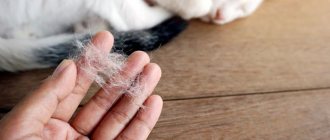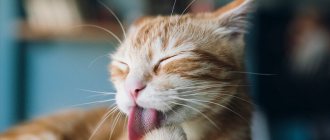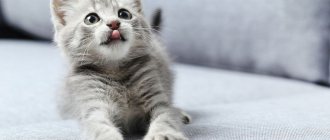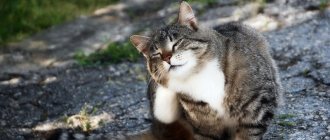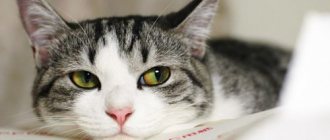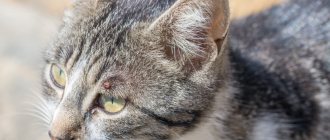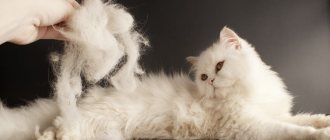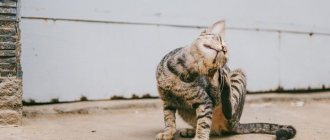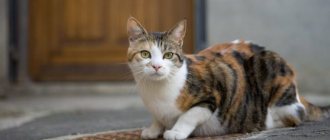The condition of a cat's hair is a reflection of the work of the whole organism. Normally, a cat sheds a small amount of hair daily or during seasonal shedding. Excessive hair loss is called alopecia or alopecia, and indicates serious health problems for your pet.
Hair is a modified part of the skin, and only part of it comes to the surface (Fig. 1). The root is attached to the hair follicle, which is surrounded by blood vessels and nerve endings. Therefore, hair loss is the result of various causes.
Rice. 1. The structure of a cat's skin.
Causes of baldness in cats
The causes of baldness in cats can be congenital or acquired.
• Congenital include those that affected the body of a pregnant cat:
- lack of vitamins and minerals in the animal’s diet;
- stress;
- diseases of various nature;
- unbalanced diet;
- starvation and, as a result, exhaustion.
Exposure to these same causes even before pregnancy can serve as a prerequisite for the occurrence of alopecia in the future generation, as a result of which the fetus experiences disruption of the endocrine glands and disruption of the formation of hair follicles.
This should also include hereditary anomalies that arise, among other things, from inbreeding. However, it is important to clarify: if hereditary anomalies are accompanied only by the absence of hair (partially or completely), and not changes in the anatomical location of organs or disruption of their functioning, then we can talk about individual, and in some cases breed, affiliation. It is these anomalies that underlie the creation of cat breeds: Sphynx, Bambino, Elf, Ukrainian Levkoy, Cojona.
• Acquired baldness in cats can be a symptom of a disease of the skin itself:
- dermatitis (inflammatory skin diseases);
- seborrhea (increased secretion of the sebaceous glands);
- parasitic diseases (scabies) or fungal infections (ringworm, favus, trichophytosis).
This also includes alopecia, as a result of aging hair follicles, or from constant injury to certain areas of the hairline.
Another large group of factors that cause alopecia in cats are disturbances in the functioning of the body itself:
- stress: the cat itself intensively licks and plucks areas of the skin;
- allergies to food, medications, flea bites, odors, low-quality pet cosmetics, etc.;
- hormonal status disorders: diabetes mellitus, insufficient or excessive levels of thyroid hormones, adrenal glands, etc.;
- intoxication (acute or long-term infectious disease);
- inflammatory processes;
- blood diseases;
- condition after difficult childbirth;
- lack of vitamins, especially groups A, C, B;
- malignant tumors of internal organs.
In some cases, the cause of hair loss in a cat remains unknown, then we are talking about the unknown nature of baldness.
Skin diseases
The presence of diseases can also affect the condition of the cat's fur and its loss. Let's list the ones that often occur and cause severe loss.
- Skin mites. A skin lesion that is very unpleasant for an animal, causing discomfort with severe itching, rashes, and inflammatory phenomena that appear in areas of the skin affected by mites. You can recognize the disease by the first symptoms, which appear in the form of dull fur and bald spots on the face, ears and front legs.
- Fungal diseases (ringworm, mycosis). Having discovered the first signs of such lesions, you cannot take any measures on your own; immediately contact a veterinary clinic. We must remember that they are very dangerous for people. A sign of a fungal disease is that the hair falls out in round bald spots, which then form entire lesions. Inside them, scaly formations on the skin are noticeable. After diagnosis, the veterinarian will prescribe treatment, which must be strictly followed.
- Flea dermatitis. Flea saliva can cause an allergic reaction in cats. In addition to extensive hair loss, it can lead to severe redness and itching of the skin. With this disease, most often cats may lose hair on their back.
- Allergic dermatitis. Cats can react to irritants such as household chemicals, pollen, dust, etc. All these substances can cause quite severe allergies, which, in addition to hair loss, causes discomfort to the pet in the form of itching, redness of the skin, and the cat develops sores in areas where it is scratched.
- Psychological reaction to external factors. The sensitivity of cats to external stimuli is not new. Any phenomenon that causes stress in an animal can make the cat not only timid and even aggressive, but also encourage him to pull out his fur with his teeth in those areas where he can reach. This includes the stomach, the back, and the paws. At the same time, bleeding wounds and ulcers appear on bald skin, which can become a gateway for various infections.
- Seborrhea. This skin disease is characterized by particularly severe hair loss on any part of the body. The skin becomes inflamed, oily, and foul-smelling.
shutterstock
Only a competent veterinarian can determine the exact reason why a cat’s hair is falling out, because the same symptoms can be a manifestation of various diseases. To make a diagnosis, you will need to undergo a series of examinations and tests. Based on the diagnosis, the doctor will prescribe treatment that will help restore the pet’s skin and coat.
Symptoms
A healthy cat's fur is smooth, shiny, firmly held in the skin, and the coat itself is not ruffled.
With the development of alopecia, areas of baldness can be complete or partial, located symmetrically or not. In some cases, the animal may scratch these areas, and the skin here may be hot and red.
Rice. 2. Partial alopecia on the back of a cat.
In skin diseases or behavioral disorders, alopecia is symmetrical on the trunk, forelimbs, thighs, sides or abdomen. The age and gender of the animal do not matter.
When stress occurs, hairs broken and torn out by the cat itself are found in the back, on the limbs, stomach and inner thighs, near the genitals and anus. Cats of “nervous” breeds are especially susceptible: Siamese, Burmesse, Himalayan and Abyssinian. These breeds will have darker hair color after restoration.
In case of hormonal imbalances, alopecia is observed in the area of the bridge of the nose, croup, base of the tail, hips, and chest. The skin loses its elasticity.
And if there is a lack of thyroid hormones in a cat, hair in the area of the pelvic bones is easily pulled out by the roots. Such alopecia, including asymmetrical ones, are recorded on the abdomen, chest and neck. The cover is restored with difficulty.
With malignant tumors, there is a complete absence of hair shafts on the abdomen, alopecia quickly spreads to the chest and limbs, and then can affect the entire surface of the skin. At the same time, the skin on the affected areas shines.
With vitamin deficiency A, alopecia areata develops: spots without hair, round in shape, form on the skin, which merge to form large alopecias. The skin has a bright pink color.
With microscopic fungi (trichopytosis, microsporia), hairless areas of the skin are reddened and may have scales and crusts, scabs and wounds.
With scabies, redness, itching, and in particularly advanced cases, purulent inflammation of the skin are observed. Dermatitis is accompanied by an increase in local body temperature, scratching, the appearance of pimples, etc.
If the course of alopecia is unfavorable, an infection may occur, and then an inflammatory process develops on the skin.
Why does a cat lick its fur down to its skin, what should I do?
A cat licks its fur down to its skin. Usually a cat washes itself after eating or sleeping - this is its normal, healthy state. Licking the fur down to the skin can signal illness.
If skin is visible in areas of excessive licking, and especially if there are several such foci of baldness, you should treat the animal as soon as possible, but it is also worth determining the cause of this behavior and trying to eliminate it.
Licking a cat's fur can occur due to:
- Nervous overstrain. In such a situation, the animal cleans its nose and whiskers, at the same time nervously moves its tail, while the pupils are dilated, as if the cat was frightened.
- The presence of an unpleasant odor for the cat. It could be a perfumed product or some kind of strong smell.
- Exacerbation of claustrophobia. Cats are terribly afraid of enclosed spaces, so any punishment of the animal by placing it in a space behind a closed door can provoke attacks of licking fur, up to the appearance of wounds on the skin.
- Development of helminthiasis. This infection with parasites, both subcutaneous and internal, is also associated with licking: with this disease, small wounds form on the animal’s body.
- Manifestations of stress and apathy towards the outside world. To stop your cat from frequent licking, you should create the most calm environment for her that does not cause fear, and try not to disturb the cat. After some time of rest the animal will return to normal.
Be sure to read:
Bald patches in a cat near the ears and above the eyes: reasons, what to do, how to distinguish normality from pathology
Diagnosis of alopecia in cats
Due to the varied nature of alopecia in cats, only a veterinarian can determine the true cause of the lesion. As a rule, the doctor will suggest approximately the following algorithm for making a diagnosis:
- collecting information about the cat’s life history and illness;
- clinical examination of the animal;
- general clinical blood test, biochemical if necessary;
- microscopic examination of hair;
- scraping from affected areas of the skin, which helps to identify diseases caused by microscopic fungi;
- Sometimes X-rays and ultrasound may be required to determine the cause of baldness.
Treatment of hair loss in cats
Treatment for alopecia in cats depends on the cause and can only be prescribed by a veterinarian. Treatment boils down to the following activities:
- symptomatic treatment: aimed at eliminating the underlying disease, the symptom of which was alopecia.
- for skin lesions by parasites: preparations for blood-sucking insects (specialized shampoos, sprays, drops);
- for infectious skin lesions: a course of antibiotic therapy;
- in case of allergies, contact with its source is excluded, and if necessary, a diet is prescribed;
- under stress: exclude factors, including those that cause licking and plucking of hairs.
The doctor will advise strengthening the immune system and increasing the resistance (stability) of the body with auxiliary means. In addition, balance the diet in terms of basic nutrients, taking into account the norms for cats of different ages, breeds, physiological conditions (pregnancy, feeding, castration, etc.).
Local medications and physiotherapy are used as an addition to the main treatment.
Treatment of alopecia is a long process that must be monitored by a veterinarian; its prescriptions must be followed exactly, since the first signs of hair restoration do not indicate a complete cure, and in advanced cases, hair may not be restored.
Dangerous complications
Overgrooming is a fairly serious deviation that can lead to negative consequences. Lack of timely and correct assistance can lead to:
- The formation of wool plugs in the stomach and intestines of cats, leading to their obstruction and accumulation of feces.
- The appearance of non-healing wounds, ulcers, scratches, which are open gates for various types of infections. In severe cases, this can lead to the formation of necrotic lesions. To prevent such situations, you need to treat wounds with antiseptic sprays and ointments, cover them with bandages and plasters.
- Disturbances in the natural growth of the coat, as well as deterioration of its protective functions.
Overgrooming is a pathology that requires a special approach, as well as great responsibility. If its cause was physiological health problems, then treatment should be aimed at eliminating them. After recovery from the underlying disease, pathological licking will go away on its own.
In the article I will describe in detail the reasons why a cat licks itself until it becomes bald, and why it licks human skin. I'll tell you what this entails. I will clarify the treatment of overgrooming in cats. I will dwell in detail on why cats lick their owner and whether it is dangerous for humans.
Licking fur is a normal state for a cat. But everything should happen in moderation. If your pet is licking its fur excessively to the point of baldness, you need to think about it. Most often this is a sign of some kind of problem. Let's look at the most common of them.
Stress
Unusual and even inappropriate behavior of a cat is not always a consequence of deteriorating physical health of the animal. Sometimes the reason has an emotional basis.
A number of situations can cause stress in a pet:
- relocation of one of the family members;
- rearrangement of furniture;
- loss of a pet's favorite toy;
- the appearance of another animal in the house and much more.
A cat's life is predictable and orderly, and anything that brings change is not always good for the pet.
Owners often try to impose rules on the cat.
Licking causing increased skin balding is abnormal
But a freedom-loving animal may have its own thoughts on this matter. It is impossible to act impudently here, and you will achieve nothing. It can cause emotional stress. It is better to find contact with the pet, some kind of mutual solution.
Compromise is the only true way out of the situation.
Itching
If your pet feels itchy, it begins to actively lick these places. Moreover, there is a pattern: a cat licks wounds more accurately than itches. If the licking area is large, it means the cat is itching there. Moreover, attentive owners have noticed that when itching, animals most often lick their back, stomach and other parts of the body.
Allergy
Mostly typical for cats. For example, for dry food, which the animal cannot eat in nature, or for its individual components. Sometimes, of course, medications cause side effects. But this happens less often. You can try changing your diet. You need to consult a specialist; you may need to take antihistamines.
Damage to the skin
Animals have no other way to restore health than to do it themselves. And licking wounds is proof of this. The pet instinctively tries to help itself. But if you have already applied the ointment, it is better to exclude this possibility. Apply a bandage or otherwise limit the animal’s access to the wound site. You can wear a special collar.
Movement restrictions
Cats by nature do not like closed doors. They will constantly be tormented by the question of what is happening in the closed area. Imagine that a person was imprisoned in an apartment and forbidden to leave. Over time, he will begin to tear out his hair. Especially if you previously liked to walk outside for a long time. And animals are no exception.
Although a cat can make do with a small space to exist, too little space is also bad. It is recommended to consider the interests of the pet. This is a living creature that also has its own needs.
